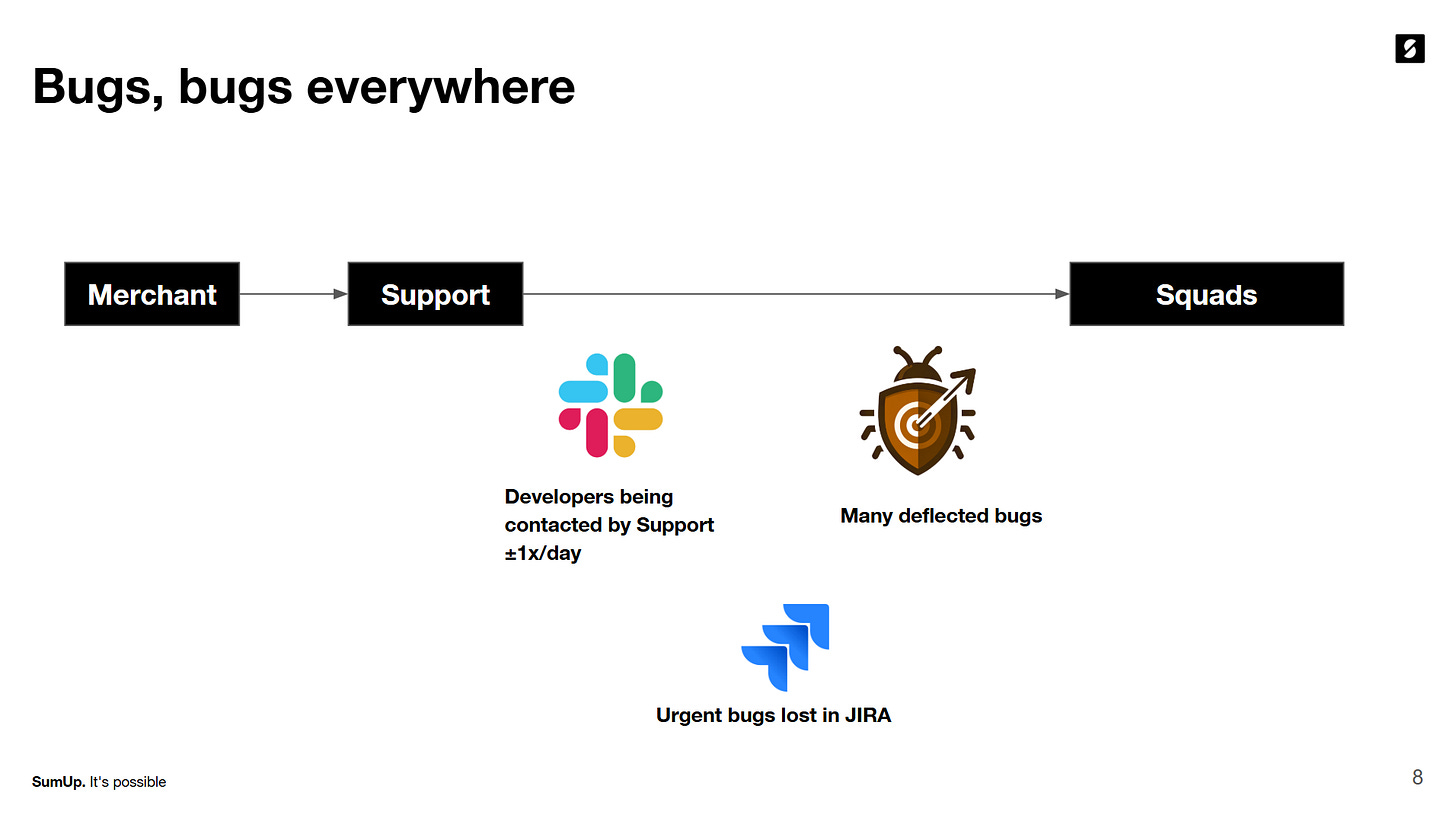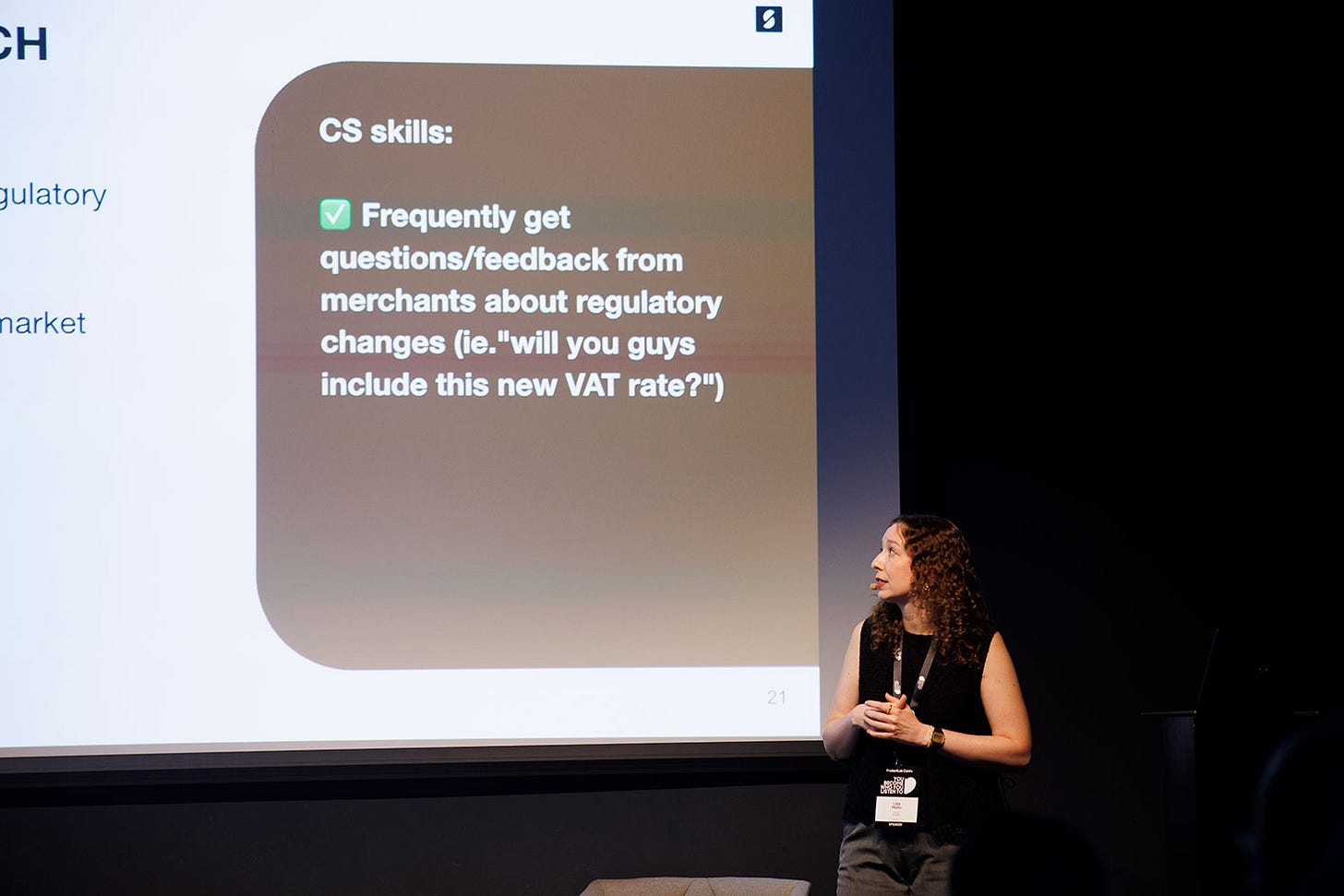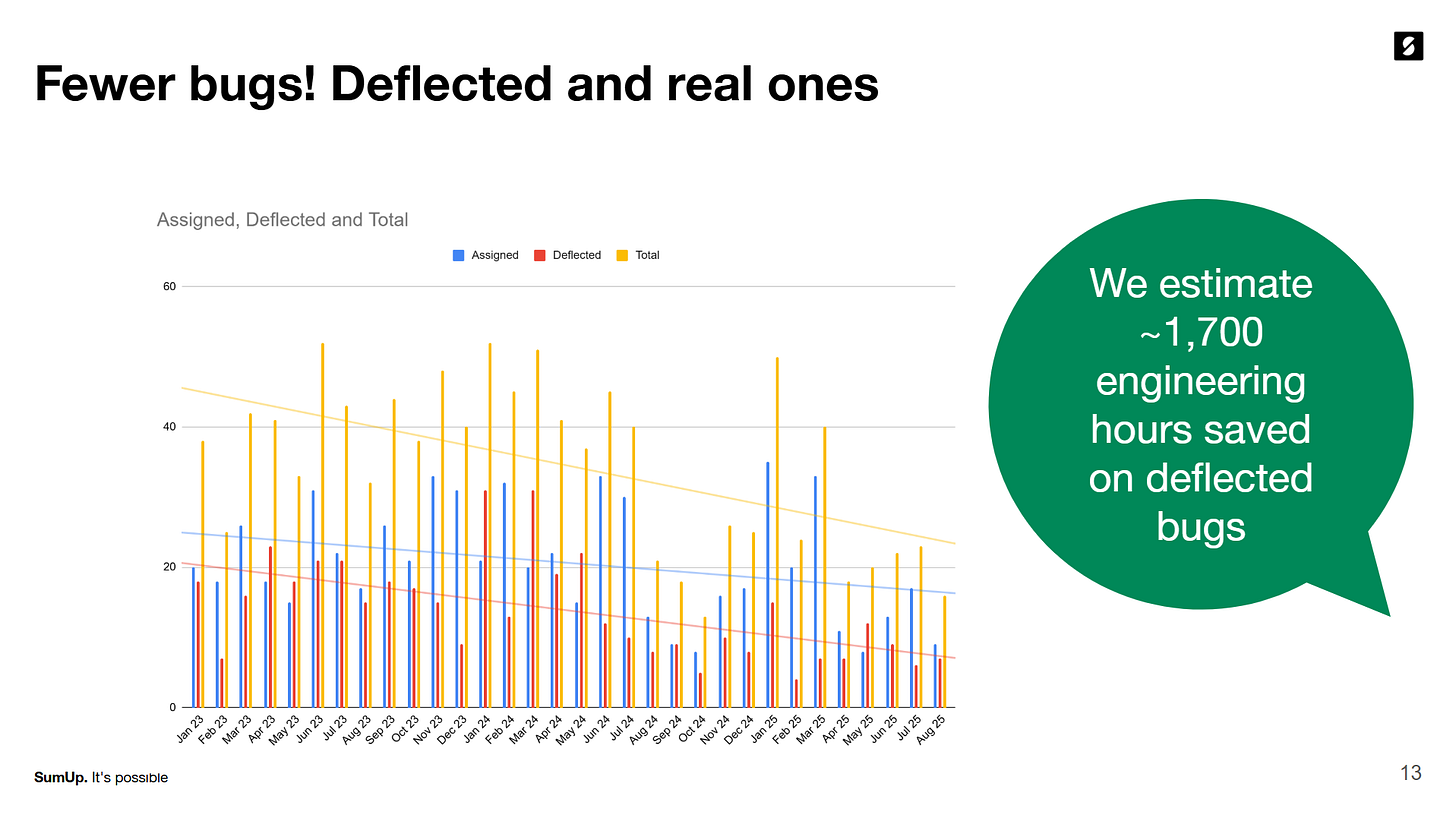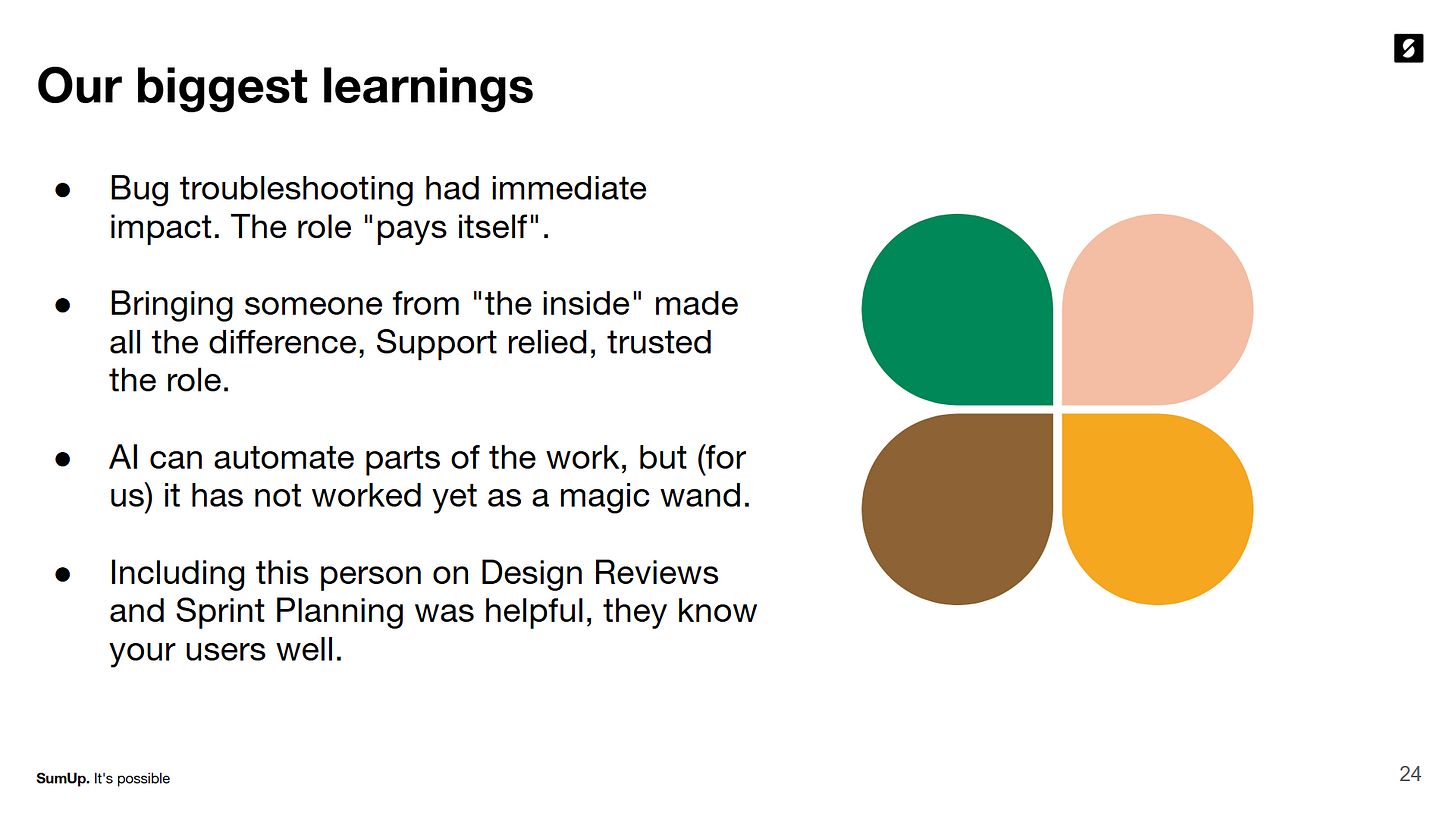How SumUp saved 1,700 engineering hours by promoting a customer support agent
A counterintuitive move that turned chaos into clarity [Slides included]
TL;DR: Liza Mello, Product Lead at SumUp, faced a common problem: her engineering team was drowning in bug reports (many of which weren’t actually bugs). Instead of hiring another PM or engineer, she promoted a senior customer support agent to a new role—part-time. The result? 1,700 engineering hours saved over three years, fewer bugs, and a scalable system that now handles merchant feedback, regulatory research, and user outreach.
The problem: Bugs everywhere, progress nowhere
Three years ago, Liza’s product team at SumUp was stuck in firefighting mode. Developers were interrupted by customer support agents at least once a day. Bug tickets got lost in JIRA. Urgent issues slipped through the cracks. And worst of all? Many of the reported “bugs” weren’t bugs at all—they were misunderstandings or feature requests dressed up as technical issues.
The team wanted to move faster and deliver more value, but they couldn’t focus. As one PM put it: “Yes, I agree we need to go faster, but my team is constantly distracted by bugs coming our way—and many aren’t even bugs. It’s wasted time.”
Classic catch-22: Product wanted engineering to ship faster. Engineering wanted Product to shield them from noise.
The unconventional solution: Hire from within
Instead of adding headcount to Product or Engineering, Liza looked inward—to Customer Support.
She recruited Alex, a senior CS agent with three critical qualities:
Deep product knowledge (could distinguish bugs from correct behavior instantly)
Attention to detail (tech-savvy, interested in engineering tools)
Trust from the support team (crucial for adoption)
The role started part-time. No budget battles. No lengthy hiring process. Just an experiment: What if Alex became a “Product Specialist” who triaged all bug reports before they reached the engineering team?
What Alex actually did (and why it worked)
Alex’s initial scope was simple but powerful:
Bug Triage:
Troubleshoot incoming issues
Enrich tickets with context (error logs, impact assessment via Grafana)
Filter out non-bugs and duplicates
Pass only validated, detailed bugs to engineering
The impact was immediate. Because Alex came from customer support, he could:
Train CS agents to troubleshoot basic issues themselves (reducing deflected bugs)
Communicate changes back to the support team organically
Distinguish real bugs from user confusion with expertise only a CS veteran could have
The numbers speak: Over three years, SumUp saw fewer bugs (both real and deflected) and saved an estimated 1,700 engineering hours—nearly one full year of an engineer’s time.
The evolution: From shield to enabler
After three months of success, Liza realized something important: This role could do more than just shield the team. It could enable them.
Alex’s scope expanded to include:
1. Merchant Feedback Insights
Alex became the team’s voice-of-customer engine, synthesizing feedback from:
Support tickets
Cancellation surveys
Trustpilot and app store reviews
Every month, Alex presents categorized insights to Product, Design, and Marketing. They discuss what’s worth pursuing immediately vs. later. (And yes, AI helps automate parts of this now, but Alex still adds the human layer of context and follow-up.)
2. Contacting Merchants
When the team gets intriguing feedback but doesn’t have time to investigate, Alex reaches out to merchants directly. He’s also supported proof-of-concept testing where part of the flow required phone calls—something PMs rarely have bandwidth for.
As Liza notes: “These won’t be as qualified as user interviews. Choose which ones you’d rather do yourself and which you don’t.”
3. Regulatory Research
SumUp operates in heavily regulated markets (invoicing, accounting). Alex monitors regulatory changes—like new VAT rates or electronic invoicing requirements—and explores potential market expansions. He does the preliminary legwork so Product can make informed decisions faster.
The AI question: Could it replace Alex?
Liza addresses the elephant in the room head-on: Could AI do all this?
Her answer: “AI definitely supports this role, but couldn’t yet automate it completely.”
Here’s why:
AI can help analyze feedback at scale, but Alex adds context, asks follow-up questions, and knows the CS team intimately
Bug triage requires judgment calls that tools can’t always make
Human relationships matter—both with the CS team (who trust Alex) and with merchants (who need a familiar voice)
That said, AI has made Alex more efficient. What used to take manual effort now happens faster, meaning one Alex can support more teams. SumUp started with a 3:1 team-to-Alex ratio and believes it can scale further.
Key lessons from Liza’s experiment
1. Start small, prove value, then expand The part-time approach avoided budget battles and allowed the team to test without commitment. Once the ROI was clear, the role became permanent.
2. Hire from Customer Support—seriously CS agents have an “untapped potential” that most companies ignore. They know the product deeply, understand user pain points, and can bridge Product and Support in ways external hires can’t.
3. Evolution over perfection The role changed dramatically over three years. What started as bug triage expanded to feedback synthesis, user research, and regulatory monitoring. Don’t be afraid to iterate.
4. Include them in rituals Alex attends design reviews and sprint planning. Why? Because he knows users better than anyone. His insights prevent blind spots before they ship.
5. AI is a multiplier, not a replacement Tools help scale the work, but the human expertise—especially from someone who’s been in the trenches—remains irreplaceable.
Is this scalable? Is it sustainable?
A great question from the audience: “Won’t you just need more roles as problems grow?”
Liza’s take: Yes, this is a permanent role. But it’s not a linear scaling problem. Better processes, automated testing, and AI tools mean Alex can handle more over time. The key insight? This role prevents problems from ballooning in the first place.
As one attendee reframed it: Alex isn’t a luxury hire. He’s Product Operations—the connective tissue that lets Product and Engineering focus on what they do best.
The bottom line
If your team is drowning in noise—bug reports, user feedback, regulatory changes—before you hire another PM or engineer, look inward. Your Customer Support team might have the answer sitting right there.
Liza’s story proves that sometimes the best hire isn’t a hire at all. It’s a promotion. And the best solution isn’t adding more resources—it’s leveraging the expertise you already have in smarter ways.
What SumUp got:
1,700 engineering hours saved
Faster feedback loops
Stronger Product-Support collaboration
A scalable model that AI enhances (but doesn’t replace)
What it cost:
One part-time role (initially)
The courage to try something unconventional
Not a bad trade-off.
Liza Mello is a Product Lead at SumUp with 14 years in product management. She leads teams across invoicing, accounting, and point-of-sale products. Before moving to Denmark, she built her career in Brazil, bringing a uniquely resourceful approach to product operations. Connect with her on LinkedIn.







